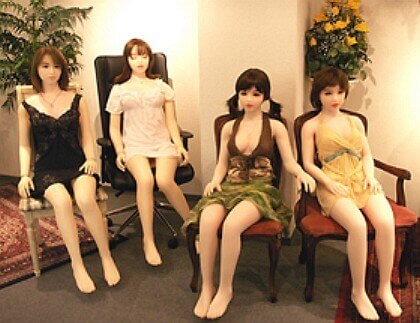Sex Tech and the Japanese Sex Crisis
Is technology the problem or the solution to the country’s waning desire to make love?
 Japan is a global leader in sex technology but is experiencing a “sex crisis” when it comes totraditional human procreative sex.
Japan is a global leader in sex technology but is experiencing a “sex crisis” when it comes totraditional human procreative sex.
A growing proportion of young to middle-aged Japanese men and women report finding sex disgusting, too demanding, or just not interesting—even as Japanese developers produce some of the world’s most realistic sex dolls.
If these factors are linked, sex technology could be the perpetrator behind Japan’s sex crisis, with virtual sex and other non-procreative alternatives undermining the nation’s interest in human-to-human sex.
Alternatively, sex technology could be the savior, becoming a tool to reignite the nation’s passion.
With an aging population, low birth rate, and low level of immigration, Japan needs to reinvigorate an interest in sex and procreation. What role with sex technology play?
Who needs a ‘real’ girlfriend?
Japan is famous for producing realistic sex dolls known domestically as “Dutch Wives.”
In 2014, Oriental Industry [NSFW] announced the release of its “most realistic” sex doll ever, which enjoyed strong early sales despite a price tag of nearly $6,000.
Advertisements for the new product claimed users would never want a “real” girlfriend again—which is exactly Japan’s problem.
As sex dolls and sex robots advance, their capacity to satisfy every physical and emotional desire of an individual will become close to complete.
Human-to-human relationships can be emotionally and physically messy, making a comprehensive robot relationship more attractive to certain individuals, even though robots cannot (yet!) conceive children.
People might also choose a robot relationship because it allows them to indulge fetishes that are difficult to discuss with human partners. They might enjoy the ability to control every aspect of the relationship or to satisfy themselves with a partner that is never “too tired” at the end of the day, particularly in Japan’s demanding work culture.
Some people may simply find synthetic partners more attractive than organic beings.
Whatever the reason, there’s an argument that the popularity of artificial sex partners is luring people away from child-bearing human relationships.
Virtual sex as a villain
The capacity for artificial sexual partners to replace human partners assumes that people are choosing between the two.
For some people in Japan, however, human relationships are not an option at all. And again, certain people blame technology.
The concept of “hikikomori,” or individuals who withdraw from society, isolating themselves in their house or even just their bedroom, has garnered increasing attention from international media over the last few years.
Various factors are linked to hikikomori, including high expectations in society and education and pre-existing mental conditions such as autism.
Some experts blame video games and virtual reality, because they allow individuals to create a virtual replacement for almost every aspect of society—including romantic relationships.
The common image is of teenagers hooked on online fantasy games such as World Of Warcraft, butmassively multiplayer online sex games are another available outlet for individuals who find it easier to “live” online than outside.
As more virtual alternatives appear to replace “real” human interaction, including sex, flirting, and relationships, the more people will take the option of withdrawing to the virtual world, abandoning the opportunity to find a child-bearing partner—or so the argument goes.
To replace or enhance?
Although it’s easy to paint sex dolls and virtual sex as villains, the counterargument is that most sex technology is designed to make human-to-human sex more enjoyable and attractive.
People who find sex difficult or uninteresting can find guides in the form of responsive sex toys, sex trackers (“Fitbits for sex”), or in the future, “smart skins” that allow them to understand exactly what their partner is feeling.
There’s an assumption that sex dolls are designed to satisfy lonely individuals, but there’s no reason they can’t be a part of a human-to-human relationship too.
Instead of luring people away from human-to-human relationships, future sex dolls and virtual sex lives could easily make those relationships better instead.
The contradiction of Japan’s sex crisis
If sex technology is intended to enhance the sexual experience, and Japan is a global leader in its development, why is it facing a sex crisis?
In some ways Japan is a good friend of sex technology, but in other ways the nation is culturally and socially drilled in habits that minimize its value.
One reporter investigating Japan’s reproductive crisis discovered that even Japan dating platforms are designed to downplay the importance of sex, unlike Tinder, for example.
Sex is considered a darkly private matter that shouldn’t be discussed in public, making the use of sex technology an implicitly shameful activity, best confined to an individual’s bedroom—rather than part of a relationship between people.
Even in the U.S., the wild west of venture capitalism, it’s difficult to secure funding for new sex technology because of the stigma.
When the use of sex technology is considered taboo in business, sex technology is obviously going to end up associated with unpaired individuals, rather than potentially child-bearing couples.
The verdict
Blaming sex technology for Japan’s sex crisis is similar to designating all sex technology as “good” or “bad.” There’s always context.
To the extent that sex technology is contributing to Japan’s sex crisis, a greater level of responsibilities lies with Japan’s “no sex, please” culture.
If Japan’s overarching cultural attitude to sex can change, the nation might find that sex technology will be more likely to be part of the solution, not part of the problem.
Image source: Dollfriend
Leave a reply
You must be logged in to post a comment.

















